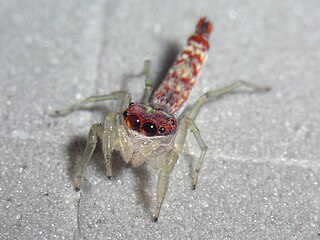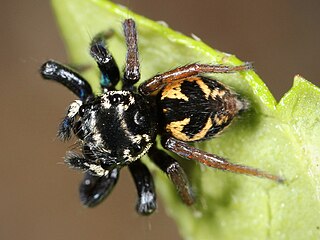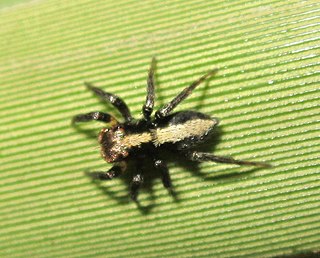Amphidraus is a genus of South American jumping spiders first described by Eugène Simon in 1900. It was previously considered a synonym of Nebridia, but this was later rejected by Jerzy Prószyński, who claimed that merging the two genera wasn't supported by previous diagnostic drawings.

Anasaitis is a genus of jumping spiders that was first described by E. B. Bryant in 1950. The name is derived from the salticid genus Saitis.

Ceriomura is a genus of South American jumping spiders that was first described by Eugène Louis Simon in 1901.

Chapoda is a genus of jumping spiders that was first described by George Peckham & Elizabeth Peckham in 1896.

Corythalia is a genus of jumping spiders that was first described by Carl Ludwig Koch in 1850.

Ilargus is a genus of the spider family Salticidae.
Laufeia is a spider genus of the jumping spider family, Salticidae, with a mainly Asian distribution, where they are found on tree trunks and branches or among leaf litter.
Omoedus is a genus of jumping spiders.
Pystira is a genus of spiders in the jumping spider family Salticidae.
Sidusa is a genus of jumping spiders that was first described by George and Elizabeth Peckham in 1895.
Tylogonus is a genus of jumping spiders that was first described by Eugène Louis Simon in 1902. It is considered a senior synonym of Phintodes.

Zenodorus is a genus of the jumping spiders distributed from the Moluccas to Australia, including several islands of the Pacific. It was once considered a junior synonym of Omoedus, but this was later rejected by Jerzy Prószyński in 2017. At least one species, Z. orbiculatus, specializes on hunting ants.
Maeota dichrura is a jumping spider species in the genus Maeota that lives in Brazil. It was first described by Eugène Simon in 1901.

Lyssomaninae is a subfamily of jumping spiders. It includes four genera, three from the New World.

Euophryini is a tribe of jumping spiders. It has also been treated as the subfamily Euophryinae.

Colonus is a genus of spiders in the jumping spider family, Salticidae. Colonus species are endemic to North and South America, ranging from New York to Argentina. All members of the genus have two pairs of bulbous spines on the ventral side of the first tibiae. The function of these spines is unknown. Colonus was declared a junior synonym of Thiodina by Eugène Simon in 1903, but this was reversed by Bustamante, Maddison, and Ruiz in 2015.

Saphrys is a genus of spiders in the family Salticidae. It was first described in 2015 by Zhang & Maddison. As of 2017, it contains 9 species.
Sumakuru is a genus of jumping spiders in the subfamily Lyssomaninae. It was first described in 2016 by Wayne Maddison. Both males and females are very small compared with other species in Lyssomaninae. As of 2017, it contains two species:
Padillothorax is a genus of southeastern Asian jumping spiders first described by Eugène Simon in 1901. As of April 2019 it contains only two species.










